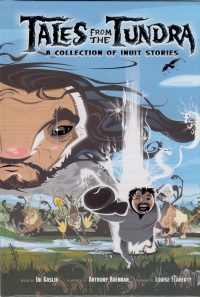| ________________
CM . . . . Volume XVII Number 21. . . .February 4, 2011. 
 |
Tales from the Tundra: A Collection of Inuit Stories.
Ibi Kaslik, reteller. Illustrated by Anthony Brennan.
Iqaluit, Nunavut: Inhabit Media (Distributed by Fitzhenry & Whiteside), 2010.
48 pp. hardcover, $12.95.
ISBN 978-1-926569-15-4.
Subject Headings:
Inuit-Folklore.
Legends-Arctic regions.
Grades 2-5 / Ages 7-10.
Review by Gail de Vos.
**/4
|
| |
|

excerpt:
Meanwhile the stranger’s wife and her family were admiring the second magnificent caribou he had caught, but they were interrupted by the jealous hunter’s screams in the distance. “Stranger, the caribou have escaped!”
Thousands of caribou galloped across the hills. The hunter dropped the caribou and walked inland, toward the herd. He felt angry yet responsible as he was worried that one day these fierce new animals, with their large, pointed antlers, would hurt the people. When he got close to the excited beasts, he drew upon all his magic as he whispered, “Be timid. Be afraid of humans and run away from them, always!”
The raging wind carried the stranger’s words to the ears of all the new beautiful animals that had escaped from the magical gash. Suddenly, they lost their confidence and became timid. Almost at once, they began to move inland, away from the human hunters. Though the stranger’s wife spent many days searching for her husband, she never found him. No one ever say the stranger again.
Although rated for young readers by the publisher, the tone, language and content of these five fairly simple retellings of traditional tales are more suitable for slightly older readers. There seems to be some confusion from the publisher about the nature of these mostly pourquoi tales as well. On the website, they advertise Tales from the Tundra as a collection of fables but call them both legends and myths on the book’s back cover. The first story, a charming trickster tale from the Qikiqtani region, relates how a siksik (ground squirrel) manages to escape the clutches of an owl by pandering to the owl’s ego and love of dance. A less straightforward tale from the same region of an old woman who creates caribou and walrus from items of her own clothing is the second offering. There is humour in the tale as the old woman realizes that perhaps the tusks would be better on the walrus than on the caribou as she originally had thought. The next tale, which contains the excerpt above, also addresses the origin story of the caribou. This tale, quite different in tone, is from the Kivalliq region. In the fourth tale, a dispute between the former friends, raven and loon, offers the explanation about their physical attributes as told among people in the same region. The final tale, from the Qikiqtani region, relates the origin story of ptarmigans and snow buntings.
Lively, manga-like illustrations by Anthony Brennan add colour and a sense of whimsy to the tales. A foreword from the publisher assures the reader of the importance of these traditional tales to the people of Nunavut and of different versions in the various regions, but, unfortunately, other than informing the reader of each of the regions in which these stories are told, there are no source notes specific to the tales. This is of utmost importance for storytellers and educators, particularly in a collection of traditional Inuit tales that are not written by someone from inside the culture. While the publisher is an independent publishing company in Nunavut, neither the author nor the illustrator is from the area. This reviewer was also confused as the foreword also offers a map of the three regions of Nunavut, but only two of the regions are represented by tales in this collection.
For school and public libraries where collections of Inuit tales for young readers are not in any abundance, Tales from the Tundra is ...
Recommended.
Gail de Vos teaches at the School of Library and Information Studies, the University of Alberta in Edmonton, AB, and is the author of eight books on storytelling and folklore.

To comment on this title or this review, send mail to
cm@umanitoba.ca.
Copyright © the Manitoba Library Association. Reproduction for personal use is permitted only if this copyright notice is maintained. Any other reproduction is prohibited without permission.
NEXT REVIEW |
TABLE OF CONTENTS FOR THIS ISSUE- February 4, 2011.
AUTHORS |
TITLES |
MEDIA REVIEWS |
PROFILES |
BACK ISSUES |
SEARCH |
CMARCHIVE |
HOME |
